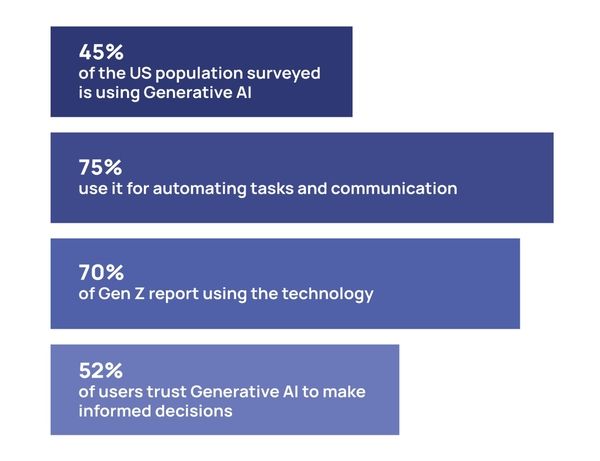
The New Colleague: Generative AI in the Workplace Is Here to Stay

Imagine using generative AI in the workplace to summarize meetings, leveraging AI for work to produce content in minutes, and embracing the future of work with generative AI integration to reallocate your time toward actual decisions. It’s not hypothetical, teams are already doing this today. Scroll down to see how yours can too.
Strategic Shift: Capturing the Value of Generative AI at Work
Generative AI in the workplace is transforming how work gets done. It’s reshaping workflows, accelerating decision-making, and opening up new ways to solve problems across departments. Teams utilize generative AI to automate routine tasks, such as writing reports, analyzing data, and drafting communications. It helps summarize complex information, highlight trends, and extract insights from internal systems, enabling faster and better-informed decisions.
67% of IT leaders surveyed said they have prioritized generative AI for their business within the next 18 months. That shows how urgent the shift is—not just hype, but a top-level strategic priority.
In day-to-day operations, generative AI improves how people communicate and collaborate. It drafts emails, meeting notes, presentations, and documentation with minimal input. Creative teams use it to generate design concepts, marketing copy, and video storyboards. These are examples of how generative AI is used in marketing and engagement. More advanced uses include simulating training or planning scenarios, generating synthetic data for testing, or developing internal tools that leverage company data. While it doesn’t replace human expertise, it does reduce time spent on manual work and frees people to focus on more strategic or creative tasks.
Streamlining Content Creation and Design with Generative AI
Generative AI streamlines and accelerates the entire content and design workflow. From drafting copy to generating visuals, it helps you work smarter and faster without compromising on quality.
Here are key ways it supports your content and design efforts:
Faster Content Generation
You can produce blog posts, marketing copy, or emails in minutes. AI helps you go from outline to first draft much faster than writing from scratch.
Higher Content Volume
With less manual effort needed per piece, you can scale your output, creating more content across more formats without needing to expand your team.
More Consistent Quality
The models are trained on large, high-quality datasets, so the content they generate is usually straightforward, well-structured, and on-topic. You still need to edit, but the base quality is strong.
Wider Content Variety
You can generate not only text but also images, video scripts, and even design ideas. It helps you cover more channels and formats without needing to switch tools or processes.
Personalization at Scale
You can quickly tailor messages to specific customer segments by feeding the model data about user preferences, behaviors, or past interactions. It’s much faster than doing this manually.
Idea Generation Support
If you’re stuck, the AI can suggest angles, headlines, or content structures to help you move forward. It’s beneficial during brainstorming or when refreshing existing material.
Faster Design Prototyping
Visual models can create design mockups or suggest layouts based on text prompts. That allows your design team to iterate more quickly and explore options early in the process.
Reusable Content Templates
Once you’ve refined a prompt or workflow, you can reuse it for similar projects. This builds efficiency over time and helps standardize tone, structure, or style.
Support for Non-experts
Teams without formal writing or design backgrounds can now create content that looks and sounds professional. That makes content creation more accessible across your organization.
Shorter Review Cycles
With a better starting point, the number of revisions drops. The review focuses on editing and alignment rather than rewriting or starting over.
Seven in 10 marketers (71%) expect generative AI will help eliminate busy work and allow them to focus more on strategic work. That expectation reflects how teams are already using these tools to shift time from tactical to high-value activities.
Impact of Generative AI in Product Design and Development
Generative AI is transforming product development by streamlining design, accelerating iteration, enhancing personalization, and improving how teams gather and apply insights. From research and ideation to prototyping, marketing, and delivery, it’s reshaping the entire product cycle. As teams adopt these tools, the real question becomes how does generative AI impact productivity in the workplace, especially when it helps cut delays, surface better insights, and keep work aligned with user needs.
Let’s look at how teams are using it in practice:
Speeding up Ideation and Design
Generative tools using AI for graphic design analyze trends and feedback to quickly produce diverse design concepts. Designers input themes or user preferences and instantly get multiple design directions. This speeds up idea generation and reduces early-stage delays.
Scaling Prototyping and Iteration
AI tools create multiple prototype versions in minutes, letting teams test and tweak quickly. Real-time feedback and fast iteration lower the cost of mistakes. This shortens time-to-market and increases flexibility.
Extracting Insight from Customer Feedback
AI scans thousands of reviews and surveys to highlight key themes and pain points. Teams use these insights to guide feature development and prioritize fixes. This replaces anecdotal input with real data.
Predicting Needs and Personalizing Recommendations
GenAI forecasts user needs based on behavior and timing, then suggests relevant products or packages. It can also generate personalized outreach for sales teams. This helps companies act before customers ask.
Powering Custom Marketing Content at Scale
AI generates large volumes of targeted marketing content across formats and audiences. Teams save time by automating repetitive writing. This frees up focus for strategy, testing, and creative work.
Marketers predict generative AI will save them five hours of work per week, which amounts to over a month per year. That’s a measurable impact on bandwidth, especially when scaling across teams.
Enabling Smarter Customer Interactions
AI chatbots now handle complex questions, guide users to better options, and flag upsell chances. They use past interactions to improve future ones. This creates smarter, faster support and sales.
Automating Competitive and Market Analysis
GenAI scans external data to compare competitors and identify feature gaps or positioning tweaks. Product teams get regular insights without manual research. This keeps your strategy in sync with the market.
Identifying Risk and Improving Product Resilience
AI simulates user behavior and stress tests products to catch bugs and edge cases. It also models cyber attack scenarios for digital products. Early detection avoids costly failures post-launch.
Supporting Sustainable Design and Production
AI suggests efficient layouts and material choices that cut waste without compromising function. This supports faster, cheaper, and greener production. It’s especially useful for supply-limited industries.
Enhancing Collaboration and Creativity
AI tools help teams brainstorm, compare concepts, and avoid creative blocks. They offer new directions based on past work and user input. This keeps collaboration smooth and ideas flowing under pressure.
“Artificial intelligence and generative AI may be the most important technology of any lifetime.”
Key Applications of Generative AI in Administrative Operations
Generative AI is streamlining everyday administrative work across teams. It reduces repetitive tasks, minimizes time spent on documentation, and enhances output consistency, enabling employees to focus on higher-value responsibilities.
Here are examples of generative AI improving workplace collaboration:
Handling Routine Processes More Efficiently
AI quickly handles tasks like data entry, email responses, and document sorting with minimal errors. Teams spend less time on routine work and more time on strategic priorities.
Simplifying Internal Communication and Documentation
AI drafts internal messages, FAQs, and documentation in the company’s voice. It reduces the need for back-and-forth by automating meeting notes and onboarding materials.
Improving Scheduling and Resource Coordination
AI tools create conflict-free schedules and manage bookings by analyzing historical patterns and real-time inputs. This reduces bottlenecks and improves team coordination.
Streamlining Record Keeping and Data Management
AI automates record updates and retrieval while supporting compliance and security. It improves traceability and simplifies reporting for audits or reviews.
Supporting Budgeting and Resource Allocation
AI analyzes past performance and spending to predict future needs and spot inefficiencies. It helps teams reallocate resources based on data, not guesswork.
Enhancing Decision-making Processes
AI models different scenarios to guide hiring, vendor selection, and project planning. Teams get faster, data-informed insights to support key decisions.
Managing Staff Operations at Scale
AI automates attendance tracking, payroll, and performance cycles. It also analyzes employee data to improve scheduling and training outcomes.
Underlying Capabilities Behind Automation
AI powers workplace automation tools by analyzing historical data and reapplying patterns across functions. They adapt quickly with minimal manual effort.
Considerations for Ethical Use of Generative AI in the Workplace
Responsible AI use requires oversight, transparency, and data protection. Companies must audit systems regularly and avoid biases in critical decisions.

“Generative AI is the most powerful tool for creativity that has ever been created. It has the potential to unleash a new era of human innovation.”
JynAI Works Is the Upgrade Your Workplace Needs
JynAI Works transforms how your team gets work done. By automating core workflows and integrating your existing tools, Works reduces manual effort and enables your teams to focus on high-impact priorities.
From marketing and HR to finance and customer success, Works adapts to your processes, integrates seamlessly with your systems, and delivers real-time insights that enhance speed, clarity, and informed decision-making. You get one platform to streamline everything without needing to switch apps or add complexity. Works make operations more efficient, decisions more informed, and outcomes more predictable.
Sign up for JynAI today or request a demo to see how Works can help your team work faster, smarter, and with less friction.
FAQs
How is generative AI used in the workplace?
Generative AI in the workplace helps with writing emails, creating reports, summarizing meetings, and supporting customer service. Teams use it to speed up repetitive tasks and improve communication. It’s becoming part of daily workflows across many roles.
What are examples of generative AI that add value?
Tools like ChatGPT, Microsoft Copilot, and Adobe Firefly help with writing, coding, and design. They produce fast drafts, generate ideas, and automate manual work. This saves time and improves quality.
How does generative AI improve workplace productivity?
Generative AI tools for content creation improve workplace productivity by handling routine tasks like writing, data summarization, and formatting. They reduce the time spent on repetitive work, allowing you to focus on more important tasks. They also help minimize errors and rework.
Can generative AI help in decision-making?
It can sort through data, highlight trends, and suggest next steps. While it doesn’t make final decisions, it helps people make better ones faster. It’s beneficial when there’s too much information to review manually.
Is generative AI safe to use at work?
It’s generally safe when used with approved tools and basic guidelines. Avoid entering confidential data and always review the output produced by the AI. The key is to treat AI as an assistant, not a final source.
Are You Ready to Make AI Work for You?
Simplify your AI journey with solutions that integrate seamlessly, empower your teams, and deliver real results. Jyn turns complexity into a clear path to success.



